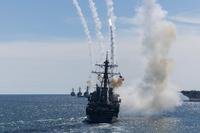Flames and flooding from a four-day firefight on a Navy amphibious assault ship left 11 of the vessel's 14 decks damaged, the service's top officer told other senior leaders this week.
Sections of the Bonhomme Richard's flight deck are warped and bulging after the fire that broke out six decks below it on July 12 spread across much of the ship, Chief of Naval Operations Adm. Mike Gilday wrote in a Wednesday message to flag officers and master chiefs. Gilday in the memo, which was obtained by Military.com, detailed what he saw when visiting the ship last week.
Read Next: Semper Supra: Space Force Unveils Official Logo
"As you are aware, the damage is extensive; there is fire and water damage, to varying degrees, on 11 of 14 decks," Gilday wrote, as first reported by Defense News. "With the flight deck as a reference, I walked sections of the ship 5 levels below and had the opportunity to examine the superstructure. The island is nearly gutted, as are sections of some of the decks below."
Damage on some decks spanned the length of the 844-foot ship and reached 106-foot-high ceilings, the CNO said. He didn't say whether the ship would undergo repairs, citing an ongoing investigation led by Naval Sea Systems Command that will likely determine that.
Two other investigations, a probe by the Naval Criminal Investigative Service to examine any signs of malfeasance, and a command investigation to look at safety procedures, are also underway.
The ship caught fire while pierside at Naval Base San Diego. The fire suppression system was turned off at the time. Navy officials haven't responded to questions about whether that's standard practice while ships are undergoing maintenance.
More than 60 people were injured during the four-day firefight.
The crew and firefighters faced two big challenges in fighting the blaze, Gilday said.
"First was wind that fueled the fire as the vehicle storage area leads to the well deck, which opens to the air at the stern gate," he said. "The second were the explosions, one in particular, reportedly heard about 13 miles away."
If not for the intense explosions, the fire might have been under control within hours of it starting. Instead, Gilday said the fire spread quickly "up elevator shafts, engine exhaust stacks, and through berthing and other compartments where combustible material was present."
"There were likely other contributing factors, but I won't speculate on that," Gilday added.
Since the Bonhomme Richard incident, small fires have broken out on two other Navy ships, Task & Purpose reported. One was on the amphibious assault ship Kearsarge and the other on the aircraft carrier John F. Kennedy.
Sailors and other firefighters responded fearlessly on the Bonhomme Richard, even as some sections of the ship reached as high as 1,200 degrees, the CNO said. Speaking to them about their actions was humbling, uplifting and reassuring, Gilday told his fellow service leaders.
Some, he said, described being knocked down by blasts, only to get back up, refocus and again attack the fire. Many showed up to save the Bonhomme Richard without being directed to do so. And most, he added, had to be ordered to go home and rest during the days-long firefight.
"How fortunate we are to serve with Sailors like them," the CNO wrote, noting that most of those who responded only joined the Navy over the last few years. "... The group I met with was preparing to head back into the ship again; some for their [eighth] time on a fire team. They had experienced the intense, inferno-like heat, the dark smoke that obscured view of teammates by their side, and the explosions -- the latter had to be like a mine field ... unknown when and where, and how severe, those blasts might be."
The Navy will learn from the Bonhomme Richard's fire, Gilday pledged, urging leaders to tackle issues within their own commands and encourage subordinates to do the same.
"Push feedback up echelon; ask for more guidance if you need it," he wrote. "... Mission readiness does not get a pass in the environment in which we operate."
-- Gina Harkins can be reached at gina.harkins@military.com. Follow her on Twitter @ginaaharkins.
Related: All Fires on the Bonhomme Richard Are Now Out, Navy Says













